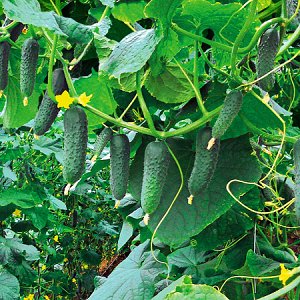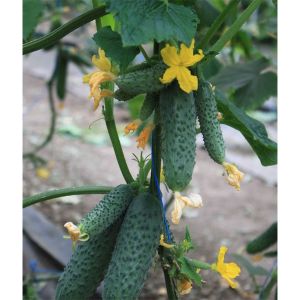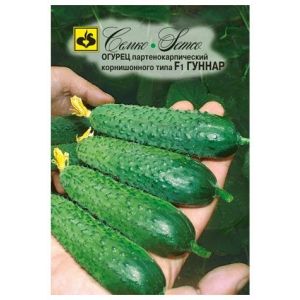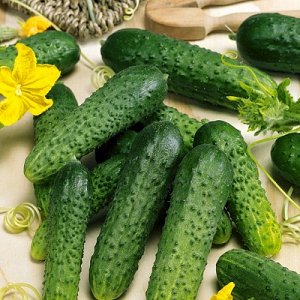Hybrid early ripe hybrid of cucumbers "Gunnar": characteristics and cultivation techniques
Cucumbers are a popular vegetable crop grown all over the world. Vegetables are successfully grown in hotbeds and greenhouses, in the beds and even on the balcony. Every year, breeders develop new varieties that are popular with gardeners.
A special place among the variety of crops is occupied by Dutch hybrids. One of the brightest representatives of this group is the early ripe Gunnar, obtained by crossing different types of cucumbers.
The content of the article
Description of the hybrid
Gunnar f1 gherkin was bred in 2010 by the international company Enza Zaden, which has been creating various varieties of vegetables for several decades.
An early ripe hybrid appeared in Russia and Ukraine in 2014 and immediately attracted the attention of farmers. The manufacturer does not disseminate information about which varieties were used to create Gunnar. The hybrid is suitable for growing in greenhouses and outdoors, but the best yields are achieved indoors.
Distinctive features
The hybrid belongs to the type of parthenocarpic plants and forms only female flowers, which do not require pollination to form fruit. It occurs faster in them than in varieties with bisexual flowers. Bouquet setting of ovaries does without fertilization.
Parthenocarpic hybrids have seedless fruits and are therefore uniform in color and size. Vegetables have a high degree of keeping quality and retain their presentation for a long time.
Features of the hybrid:
- has an early ripening period;
- grows on slightly saline soil;
- resistant to adverse weather conditions;
- does not need pollinators;
- does not require pre-sowing treatment of planting material;
- has immunity to powdery mildew and cladosporium, moderately resistant to yellowing, cucumber mosaic and peronospora;
- fruits are absolutely ripe;
- gives up to 4 harvests per season;
- vegetables have a juicy sweet taste.
Composition and properties
Cucumbers are 95% composed of useful structured water, which removes toxins and heavy metal salts from the body through the kidneys.
The composition of Gunnar cucumbers includes minerals: potassium, zinc, magnesium, copper. The pulp contains manganese, chromium, iron, iodine, phosphorus, sodium, chlorine, vitamins B1, B2, PP, A, C and beta-carotene.
Regular consumption of fresh fruits gently cleanses the intestines thanks to the dietary fiber and fiber in cucumbers. Digestion is noticeably improved, toxins and excess cholesterol are eliminated.
Fresh fruits are consumed:
- as a therapeutic food for diseases of the liver, kidneys and gastrointestinal tract;
- for dietary food for obesity;
- for the prevention of diseases of the cardiovascular system;
- when cholesterol plaques appear on the walls of blood vessels;
- with high physical exertion and chronic fatigue.
Cucumbers are useful for those who want to lose weight: they are not only tasty, but also low-calorie product. For prophylaxis, unloading "cucumber" days are arranged, which normalize metabolism and remove excess fluid and salt from the body.
The calorie content of the product is only 15 kcal per 100 g.
Proteins - 0.8; fats - 0.1; carbohydrates - 2.8.
Cucumbers are also used for external use as a remedy for acne and freckles. On their basis, face masks, lotions and cosmetic water are made.
Characteristics and yield
The Gunnar hybrid belongs to the salad and canned types. Fruits are dark green, fusiform with large tubercles on the surface. The length of the cucumbers is 10-16 cm, the weight is 85-117 g.
Depending on the care and growing conditions, 3-5 fruits are formed in the nodes. Cucumbers are removed every other day, and with a rich harvest - every day.
With high-quality agricultural technology, the hybrid is highly productive. In the spring-summer period, 17–23 kg of vegetables per 1 m2 are harvested, in the summer-autumn period - 8–13 kg. Such abundant fruiting requires a lot of fertilization.
The fruit taste is sweet, without bitterness. The homogeneous flesh without voids makes the gherkins suitable for consumption both fresh and canned... For pickles and salting use late harvest. Fresh vegetables are used immediately after harvesting, since every day they lose their beneficial substances and taste.
How to grow yourself
The seeds of the Gunnar hybrid are not processed before sowing - the manufacturer has already taken care of this.
Planting with seeds and seedlings
Seeds are planted to a depth of 1-2 cm at a topsoil temperature of at least +17 ° C.
Soil requirements:
- increased air permeability;
- neutral pH;
- high humidity;
- high percentage of soil bacteria.
Complex fertilizers are applied to the garden bed, the furrows are watered well, then the seeds are laid and sprinkled with earth.
For growing seedlings, the ready-made soil mixture is poured into special cassettes or other suitable container. A seed is placed in the center and 1 cm of soil is sprinkled.
The container is placed in a warm, well-lit place. After emergence, the temperature is lowered to +20 ° C. Saplings are watered with warm water. By the time 3 leaves appear, they are planted in a permanent place. Finish planting with mulching.
Step-by-step cultivation and care
Gunnar cucumbers need constant watering warm water. It is important to ensure that no drops fall on the leaves and stems. Often, gardeners install a convenient drip irrigation system.
From the moment of plant development, moderate watering is carried out, and from the beginning of fruiting, its volumes increase. Each bush provides 1-2 liters of water, then 4 liters.
For good yields, plants are fed with complex mineral fertilizers. Contents of 1-2 liters are applied per 1 m2.
After moisture or rain, the soil is loosened and weeds are removed.
Features of cultivation and possible difficulties
With drip irrigation, the tape is not placed under the mulch, but on top of it. For the active formation of ovaries from planting to flowering, moderate irrigation is carried out, then it is increased, since Gunnar is picky about moisture. This feature involves the consumption of large volumes of water.
Important! Keep track of the water volume without leaving the soil too moist or dry.
With each subsequent feeding, the fertilizer should contain less nitrogen and slightly more potassium and phosphorus.
Unlike non-hybrid cucumbers, Gunnar forms into a single stem. For the correct development of the bushes, the procedure of "blinding" is carried out: all shoots and ovaries that have formed at a height of 5–8 internodes from the ground are removed. The ovaries that form above are left, and if shoots appear, they are also removed. Pinch the bush at a height of 3 or 5 leaves from the point of growth.
For a garter, it is more convenient to use a net, guiding the stem and wrapping it around the cells. When Gunnar is grown outdoors, the height of such a device is about 2 m, and for greenhouse cucumbers, its dimensions are determined by the height of the room.
The lower dried leaves are removed in the morning or evening hours. During this time, the plants will not experience severe stress.
Diseases and pests
Gunnar is resistant to the most common plant diseases. If all care measures are followed, the risks of plant damage are low.
For the prevention of fungal diseases, the bushes are sprayed with sodium polysulfide. To prevent infection with downy mildew, the beds are treated with fungicides.
When Gunnar is grown in greenhouse conditions, insects do not threaten him. In the open field, the crop is attacked by a sprout fly, spider mite and melon aphid... To get rid of them, plants are treated with karbofos or tobacco solution.
Harvesting and application of the crop
The crop is harvested one month after planting. The first cucumbers are removed from the bushes before they reach their maximum size. This will reduce the stress on young plants and stimulate the growth of new fruits. Remove vegetables early in the morning or late at night to retain moisture, firmness and crunch.
Fresh cucumbers are versatile in use: they are used for making salads and preserving.
The crop is stored in a cellar for several days at an air humidity of about 90–95%. If you keep it longer, the taste will change under any conditions and the skin will become wrinkled.
Advantages and disadvantages
The benefits of the Gunnar hybrid include:
- early ripening;
- abundant fruiting;
- resistance to diseases and pests;
- long-term preservation of the presentation of the fruit.
Disadvantages:
- high price of seeds;
- zoning of cultivation (suitable for the third and fifth light zones).
Reviews
Experienced gardeners shared their opinion on the productivity of the hybrid:
Vladimir, Kursk: “I have been growing Dutch cucumber hybrids for a long time. Of the several varieties, Gunnar is considered the most productive. It bears fruit actively from late spring to autumn. The cucumbers are neat, small and even. The harvest is stored for a long time and is perfectly transported. "
Elena, Volgograd: “Despite the high cost of seeds, I took a try. Grown indoors. Gathered the first harvest in 1.5 months. Zelentsy up to 9 cm long, sing together. When planting, I bring in humus and ash. The pulp of cucumbers is aromatic and tasty. We eat fresh with the whole family. "
Conclusion
With proper agricultural technology and careful care of the Gunnar hybrid, a rich and high-quality harvest of cucumbers is provided. The main advantages of the culture are its resistance to diseases and pests, excellent taste and commercial characteristics of the fruit. The hybrid does not need pollinators and can harvest up to 4 crops per season.